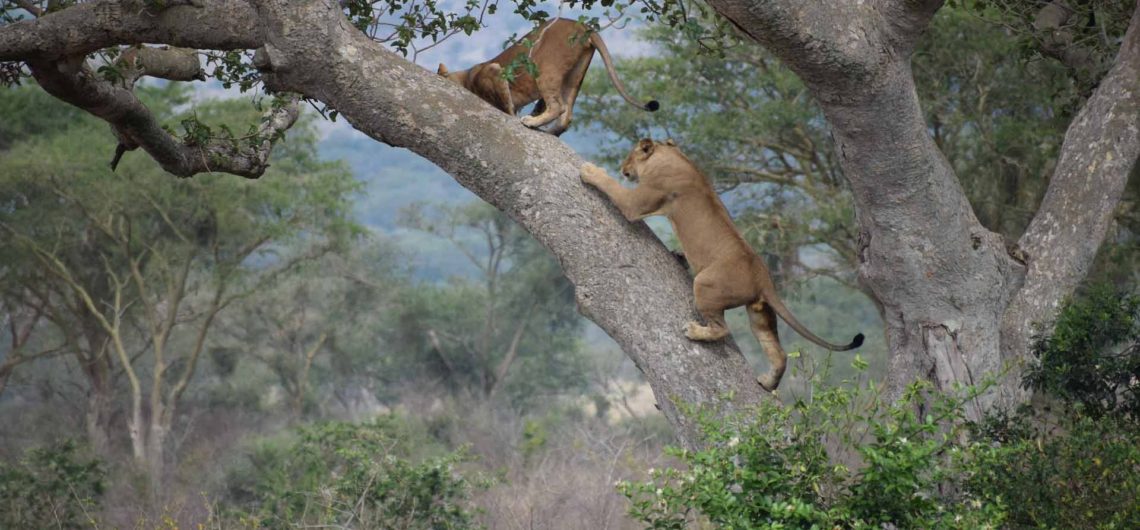Tree Climbing Lions in Uganda, what you did not know
Uganda wildlife authority identify about 5 prides of Lions that have a behavior of climbing fig trees in Ishasha wilderness, Queen Elizabeth National Park.
This park receives the highest number of visitors in Uganda, because of its combination of activities such as game drive safari, boat cruise on Kazinga channel and chimp trekking.
So why do Ishasha lions climb trees?
So among the big cats, only leopard and jaguar can climb trees efficiently but we have lions that climb trees also.
National geographic explorer Alexander Braczkowski visited Uganda in 2018 to prove why Ishasha lions climb trees. Firstly, he found that there are stinging insects in Ishasha that fly close to the ground. As a result, lions learn to climb trees where its comfortable to relax especially after a kill. Secondary, the lions also climb to the tree branches to get a good view of prey.
These lions climb trees at different times of the day. Between 9:00am, 11:00pm, 1:00pm to 3:00pm most visitor going through Ishasha spot the lions. However, it’s also true that a number of visitors miss to see them as well.
Lions with a behavior of climbing tree have also been reported in two Uganda national parks – Kidepo Valley National Park and Murchison falls national park. Around East Africa, tree climbing lions are also reported in Lake Manyara National Park in Tanzania. It’s not clear if the reasons for Ishasha lions to climb trees are same for lions else in East Africa.
Best Chance to see ishasha lions?
Queen Elizabeth national park is divided into two sectors.
They include; Kasenyi area in the north includes Kazinga channel, Mweya peninsular, kyambura gorge, several crater lakes including Lake Katwe where salt mining takes place.
Ishasha lies in the south west of the park. So most visitors drive through Ishasha from Queen Elizabeth to Bwindi forest or from Bwindi to coming Queen but if you are just driving through, you may or may see tree climbing lions.
However, if you overnight in Ishasha it gives enough time for game drive and high chance to see tree climbing lions. Likewise, when you leave Kasenyi early morning, it gives you enough time for game drives in Ishasha before you continue further southwest.
Lion Tracking in Queen Elizabeth National Park
Kasenyi plains has lions that do not climb trees. Although it’s no guarantee to see lions, the Experiential Lion tracking does. Paying for lion tracking allows to go off road (what other visitors are not allowed to do) to look for lions and get close to them for 2 good hours.
Wildlife in Queen Elizabeth National Park
Over 79 mammals live in Queen Elizabeth National park.
Large mammals include African elephant, cape buffalo, hippo, leopard. Antelopes include Uganda kob, waterbuck, topi and there are also over 600 bird species including flamingos.
Do not expect to see large herds of animals such as those in Masai Mara kenya or Serengeti Tanzania.
However, on game drives in the park, you will be able to spot wildlife such as buffalo, elephant, Uganda kobs, buffalo and other wildlife in the park.
Also you will be able to sight a lot of other mammals while on the boat cruise along the famous Kazinga channel but also the scenery of the park is beautiful particularly the crater lakes, Ishasha, rift valley and a backdrop of Rwenzori mountains.
Activities in Queen Elizabeth National Park
Besides game drives and boat cruise, there are a number of activities. Experiential tours include lion tracking, mongoose tracking, bird counts and hippos census.
These are booked in advance and you can visit lake Katwe to see the process of salt mining and you can also do Chimpanzee trekking in Kalinzu forest reserve. Nature walks are available in Kyambura gorge. Community and cultural tours are available as well mostly outside the park. Kasoga community experience is found in Hamukungu landing site on the shores of Lake George. The experience offers several activities such as canoe rides, village walks and fishing tours.
How you can help save the tree climbing lions of ishasha
It’s unfortunate one pride of 11 lions was poisoned in 2018 after attacking livestock in the community. Along with the Uganda Wildlife Authority community conservation programs, National geographic explorer Alexander Braczkowski who had been filming the lions started GoFundMe, a charity that is raising money to compensate local people that loose livestock from predator attack.

